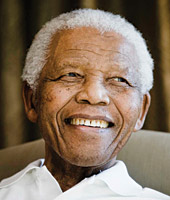Making History: Catalysts for Change
Nelson Mandela

Photo of Nelson Mandela by Theana Calitz/Associated Press. |
Some leaders not only dedicate their lives to a cause, but they also develop innovative solutions to problems that others haven’t been able to address.
By the time he was released from prison on February 11, 1990, Nelson Mandela had already demonstrated his commitment to ending apartheid in South Africa by spending 27 years as a political prisoner. He even passed up opportunities for release because the conditions the government offered him would have harmed the anti-apartheid cause.
“I think his life would not have been nearly so powerful without
his 27 years in prison,” says Denise Daniels, SPU professor of management. “He was viewed as someone who was willing to stand up for what he believed in spite of high
personal cost.”
But how could Mandela and others ensure that South Africa’s transition out of apartheid was not violent?
Mandela saw reconciliation as the only solution. When he became president in 1994, he worked with Archbishop Desmond Tutu and others to establish the Truth and Reconciliation Commission, in which people on all sides testified about the injustice of apartheid and human-rights offenders could request amnesty for their crimes.
“This was a novel and risky approach, but Mandela thought it was the only way to heal the nation,” Daniels says.
Mandela also supported South Africa’s 1995 rugby team (the subject of the 2009 film Invictus), reaching out to white fans to demonstrate his goal of uniting black and white South Africans.
In the 20 years since his release from prison, Mandela has continued to speak out for reconciliation worldwide. And the Truth and Reconciliation Commission became a model for other countries such as Rwanda, which established a similar commission after its genocide.
Winston Churchill
Rosa Parks
Martin Luther King Jr.
Mother Teresa
Oprah Winfrey
Steve Jobs
Nelson Mandela
Return to top
Back to Features Home
|